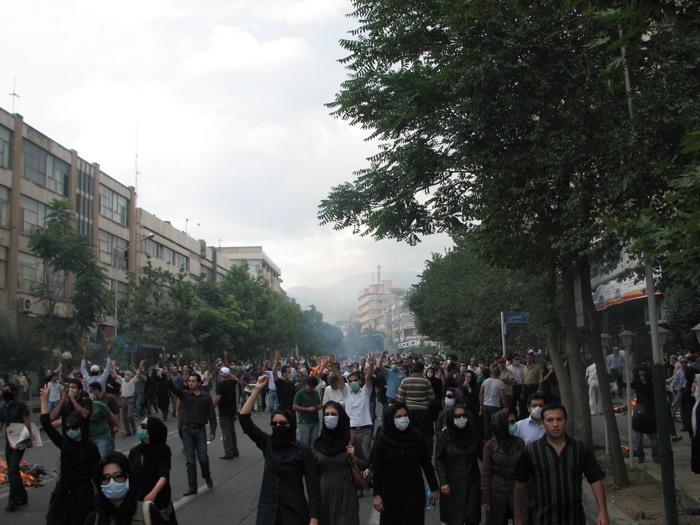On Saturday, June 20 and Sunday, June 21, the mass movement in Iran took another step forward. After a full week of illegal mass demonstrations, the Supreme Leader Ali Khamenei had made it clear that no more protests would be allowed, and that the full force of the repressive apparatus would be used. That did not stop the movement. On both days, thousands came to the streets and when prevented from demonstrating by the police and other repressive forces they fought back, and in some cases forced the police to retreat. Nothing will be the same after this weekend.
On Saturday, June 20, at 4pm despite massive police presence in both Enghelab and Azadi Square and in the streets between, people started to gather and try to get in for the planned demonstration. The people were pushed in one direction and then another by the police and the Basij militia. But finally they managed to regroup in a crowd large enough to start a demonstration. Here’s an eyewitness account:
“Then at Towhid Square the scene changes drastically. The streets to Azadi are blocked. But this time, people don’t change their path. They fight for it. There’s a shower of stones. Tear gas. Fire. People jam the sidewalks. The battle scene is huge. We cannot see the limits but it extends to nearby street. (...) The people shout, ‘Down with the dictator’. The anti-riot police are also throwing stones. People don’t run back anymore. I grab a broken brick and throw. I’m amazed. I never thought I’d do it. I should practice. It was a very bad shot. I grab another one, the size of a pomegranate and keep it with me, hiding it behind my back. My feeling is a mixture of a university teacher and a hooligan.”
For the first time in the movement the people are confronting the forces of the regime openly and fighting back when attacked. There are videos showing some of these confrontations.
Also, they are supported by ordinary people. Another eyewitness says that: “people were running into houses, seeking protection from homeowners who had opened their doors.” This is significant, since it means that even people who do not dare participate in a demonstration that has been declared illegal, nevertheless sympathise with the movement and give support.
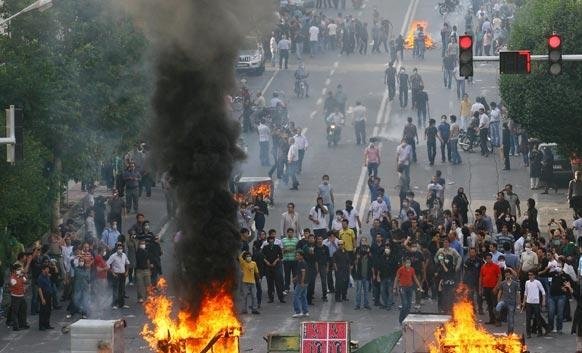 Demonstrators in Tehran fighting back forces of the regime, Saturday June 20. Photo by .faramarz Also, the university teacher quoted before makes an interesting point:
Demonstrators in Tehran fighting back forces of the regime, Saturday June 20. Photo by .faramarz Also, the university teacher quoted before makes an interesting point:
“Here’s a true battleground. And this time it’s huge. Columns of smoke rise to the sky. You can hardly see the asphalt. Only bricks and stones. Here people have the upper hand. Three lanes, the middle one separated by opaque fences, under construction for the metro. The workers have climbed up the fences and show the V sign. They start throwing stone and timber to the street to supply the armament. I tell myself, ‘Look at the poor, the ones Ahmadinejhad always speaks of.’” (our emphasis)
This is very important because it shows, contrary to what some ultra-left sectarians and cynics have argued, that the movement is not a middle-upper class movement, but rather a genuine movement of the people, workers, students, women, etc.
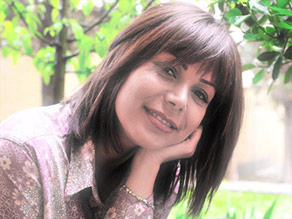 Neda, a young woman protester was shot and died during the demonstration on Saturday At the end of the day, after 5 hours of fierce confrontations, in which the anti-riot police, the Basij militia, the Sepah Special Forces and plainclothes officers and provocateurs used battons, tear gas, water cannons and live ammunition, some sort of semblance of calm is restored in Tehran. According to official sources between 10 and 19 people have been killed and hundreds arrested. The shooting and death of a young woman protester named Neda on Kargar Street was captured on video, further angering and becoming a rallying cry for the movement. (Open video in a new window)
Neda, a young woman protester was shot and died during the demonstration on Saturday At the end of the day, after 5 hours of fierce confrontations, in which the anti-riot police, the Basij militia, the Sepah Special Forces and plainclothes officers and provocateurs used battons, tear gas, water cannons and live ammunition, some sort of semblance of calm is restored in Tehran. According to official sources between 10 and 19 people have been killed and hundreds arrested. The shooting and death of a young woman protester named Neda on Kargar Street was captured on video, further angering and becoming a rallying cry for the movement. (Open video in a new window)
“Death to Khamenei”
On Saturday night the chants against the regime from rooftops that had been heard on previous night grew louder and more radical. Yasaman Baji, a journalist writing for IPS reported that:
“Not only did the shouts appear louder and more sustained Saturday night, however, the slogan ‘death to the dictator’ was heard more prominently than before. In some streets, the shouts turned into ‘Death to Khamenei.’”.
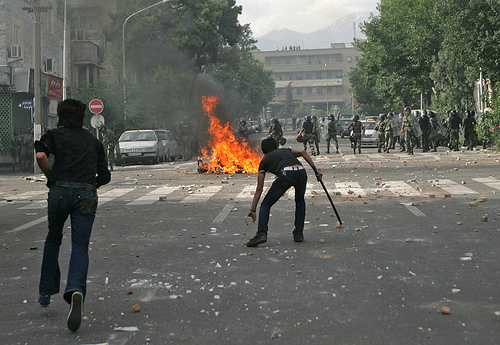 Demonstrators in Tehran fighting back forces of the regime, Saturday June 20. Photo by Current News Stories. Clearly, after Friday’s speech by Khamenei, the movement increasing sees itself pitched not only against electoral fraud but against the Supreme Leader of the Islamic Republic himself. Baji comments on this:
Demonstrators in Tehran fighting back forces of the regime, Saturday June 20. Photo by Current News Stories. Clearly, after Friday’s speech by Khamenei, the movement increasing sees itself pitched not only against electoral fraud but against the Supreme Leader of the Islamic Republic himself. Baji comments on this:
“With Khamenei’s words Friday and Saturday’s popular reaction, the Green Movement appears to have entered a new phase in which its growing number of adherents see the highest authority in the land as the main obstacle in the historic struggle for the rule of law and a just order in Iran.”
The female university teacher we have quoted from before, also reports of a conversation with another woman on their way back from the clashes: “It’s no longer about Mousavi or election results. We have suffered for thirty years. We didn’t live a life.” She also explains how a taxi-driver tells them that “he did not vote, but he has come out to the streets to beat the Basijis”.
As we have explained in the articles last week, the movement that has been unleashed inevitably is starting to question the whole foundation of the Islamic Republic, not just the issue of election fraud. Mousavi has been the accidental figure who has channeled the movement, but he does not have control over it and his own popularity might disappear very quickly if he attempts to compromise.
This is clearly expressed in a newspaper that has been distributed in some of the protests, starting on Thursday, under the name Khiaban, “The Street”. In an article called “We rely on the streets”, by one Simin Mesgari, she explains:
“Mousavi knows too well how deep the wound is. He also knows that his green bandage is only a first aid cover for this wound and not a cure. Mousavi knows that he can’t be both the cause of pain and cure at the same time.
“Mousavi knows that not all ‘this’ is for him. He knows very well, and we also know very well that had there been a ‘better’ candidate than Mousavi with a ‘lesser evil past’ which had chosen yellow colour for his campaign, the nation would have gone yellow and Mousavi would have demoted to Ahmadinejad’s position. …
“One can’t know all this and not be scared about the consequences of what has been unleashed. These protests can get out of control. The ultimate demand of this campaign is far from presidency of Mousavi, even though its official colour is still green.”
And referring to the call last week by Mousavi for people to mourn their dead at the mosques on Friday (instead of demonstrating in the streets), the same author comments:
“Streets are dangerous, not just for us but more for them. That’s why they are trying to pull us from the street by inviting us to attend the Friday prayers after we have mourned for our dead brothers and cried over our destroyed homes. Ironically it is Mousavi who is inviting us to attend. To make a joke out of our protest, they are inviting us to attend mosques, because they are scared of ‘streets’ but they should know that ‘we rely on the streets’.” (Open this issue of “The Street” as PDF)
We don’t know anything about this paper or the political tendency of its authors, but clearly the above lines give a very interesting insight on the character of the movement. Interestingly, we have received reports that “The Street” published a Persian translation of Alan Woods’ article “Iran, the revolution has begun” (See the last page of this issue of “The Street” (PDF))
The clashes and demonstrations over the weekend were not limited to Tehran, but spread to many other cities and regions in the country, including Tabriz, Shiraz, Isfahan, Sanandaj, Rasht, Arak, Sari and Ahvaz.
On Sunday, again, there were thousands of people in the streets, though clearly the numbers had gone down after the violent repression on Saturday, but again, in some instances, the people managed to gather and march, despite heavy repression. See for example the following video:
It is important to understand that this movement is spontaneous, without a leadership, and taking place in conditions of extreme repression, where there is censorship of the news, of the means of communication, and where it is extremely difficult to get information around. Yet none of this has stopped the movement.
However, a revolutionary movement cannot be sustained for any length of time without organisation and leadership. The people have already established some basic informal structures, which have allowed the gathering of hundreds of thousands by word of mouth, email, internet, local networks, etc. These should be put on a democratic footing with the democratic election of spokespersons at mass meetings in every factory, workplace, neighbourhood, university college and dormitory, which should then link up at a local, regional and national level. This would be the only way to give the movement a democratic and accountable leadership. Some of this will have to be done in an extremely careful fashion, and at this stage the committees will necessarily be clandestine, but the sooner a national leadership of the movement, one accountable to the rank and file, is established, the better.
Splits in the regime
Meanwhile, there are clearly strong divisions at the top of the regime. Four relatives of Rafsanjani were arrested for a period of time on Saturday and later released, as well as many middle rank officers of the Mousavi campaign. The arrest of Rafsanjani’s relatives was not because they were participating in the movement, but rather because they were involved in trying to get a statement from the clerics in Qom to come out against Ahmadinejad and Khamenei. The Dubai based Al-Arabiya News channel reported that
“Iran's religious clerks in Qom and members of the Assembly of Experts, headed by Ayatollah Rafsanjani, are mulling the formation of an alternative collective leadership to replace that of the supreme leader, sources in Qom told Al Arabiya on condition of anonymity. (...) The discussions have taken place in a series of secret meetings convened in the holy city of Qom and included Jawad al-Shahristani, the supreme representative of Ayatollah Ali al-Sistani, who is the foremost Shiite leader in Iraq.” (Iranian clerics seek supreme leader alternative, Al Arabiya)
Rumours say that at this point Ayatollah Rafsanjani has a letter signed by 40 members of the powerful 86-member Assembly of Experts calling for the annulment of the recent presidential election results.
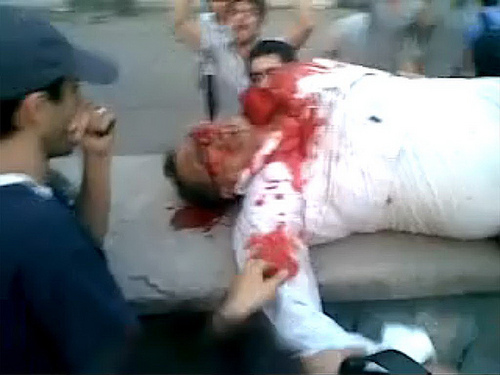 Another demonstrator who was injured and died during the demonstration on Saturday. Clearly, the section of the regime around Rafsanjani, Khatami and Mousavi himself, are worried about the spread of the mass movement and its increased radicalisation and are looking for a solution from above, seeing that the whole edifice of the Islamic Republic is threatened by a mass revolutionary movement from below.
Another demonstrator who was injured and died during the demonstration on Saturday. Clearly, the section of the regime around Rafsanjani, Khatami and Mousavi himself, are worried about the spread of the mass movement and its increased radicalisation and are looking for a solution from above, seeing that the whole edifice of the Islamic Republic is threatened by a mass revolutionary movement from below.
In a statement on Saturday, Khatami warned that unless a negotiated settlement is reached from above, “God knows what will happen”:
“Public trust is damaged, and to close the doors of civic protest to them is to open dangerous paths, that only god knows where will lead to. People's rights must be protected, and while provisioning measures to prevent chaos and instability (which is far from the intentions of the people), expensive and damaging tactics such as military confrontation and violence must be put aside. We all need to mobilize to repair public trust, which is the principle basis of the government and the state.”
Mousavi himself is very aware (and frightened) of this. In his Saturday statement he said that:
“If the high volume of cheating and vote manipulation, that has put a fire to the foundations of people's trust, is itself introduced as the proof and evidence of the lack of fraud, the republicanism of the regime will be slaughtered and the idea of incompatibility of Islam and republicanism would be practically proven”.
Basically he is warning that if there is no reform, the whole basis of the regime will be undermined, which is what he fears most. And just to underline the point he concludes:
“We are not up against our sacred regime and its legal structures; this structure guards our Independence, Freedom, and Islamic Republic. We are up against the deviations and deceptions and we want to reform them; a reformation that returns us to the pure principles of the Islamic Revolution.”
The problem is that through their experience in the mass movement over the last week, the masses are learning very quickly. First they recognised their own strength by mass demonstrations. Now they have been forced to oppose the Supreme Leader and clashed with the riot police. For many, it is no longer a question of reform, but one of revolution.
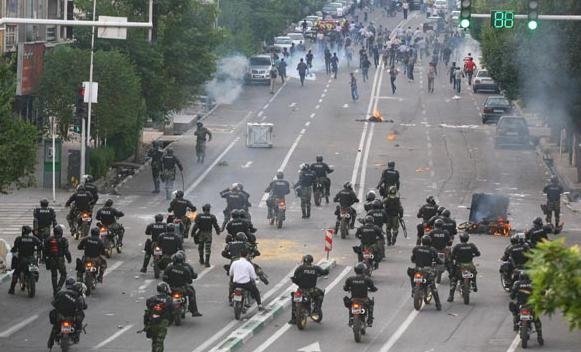 Confrontation between police and demonstrators, Tehran, Saturday June 20. Photo by .faramarz On the other hand the Khamenei-Ahmadinejad wing of the regime is determined to crack down. In a statement posted on the Revolutionary Guards website today they said:
Confrontation between police and demonstrators, Tehran, Saturday June 20. Photo by .faramarz On the other hand the Khamenei-Ahmadinejad wing of the regime is determined to crack down. In a statement posted on the Revolutionary Guards website today they said:
“Be prepared for a resolution and revolutionary confrontation with the Guards, Basij [pro-government militia] and other security forces and disciplinary forces. […] The Guards will firmly confront in a revolutionary way rioters and those who violate the law.”
Neither of these two wings can ultimately solve the situation. However, this infighting is providing the masses with time to become bolder and more radical.
In an extraordinary admission, on Sunday June 21, the Guardian Council admitted that there had been fraud in the election. One of the presidential candidates, “conservative” Mohsen Rezaei, had alleged that he had been robbed of between 3 and 7 million votes and claimed that in 80 to 170 cities more than 100% of those eligible to vote had voted (!!). On behalf of the Guardian Council, Abbas-Ali Kadkhodaei spoke on the Islamic Republic of Iran Broadcasting (IRIB) Channel 2, and said that “statistics provided by the candidates, who claim more than 100% of those eligible have cast their ballot in 80-170 cities are not accurate - the incident has happened in only 50 cities”!! He then went on to explain that a turnout of over 100% was a “normal phenomena because there is no legal limitation for people to vote for the presidential elections in another city or province to which people often travel or commute”. This is a case of “vote early vote often”. Kadkhodaei added that in any case the final results of the vote would not be affected as this only affected about 3 million votes!!
How anyone can make such an admission and keep a straight face is amazing. Coming after Friday's strongly worded speech by Khamenei to the effect that there was not even a remote possibility of fraud in the Islamic Republic, this public admission of fraud will further undermine the legitimacy of the regime and the elections in general in the eyes of the masses.
A “colour revolution”?
Some have raised the idea that this is just another “colour revolution”, that is, that the movement is somehow manipulated by Western imperialist powers, like the Orange “Revolution” in the Ukraine, the Rose “Revolution” in Georgia, etc. It is clear that neither the US nor the UK have any right to interfere in the internal affairs of Iran, and their own track record of supporting reactionary military dictatorships around the world does not give them any moral standing to criticise the Iranian regime. There is a long and bloody history of imperialist intervention in Iran, particularly the overthrow of the Mossadeq in 1953.
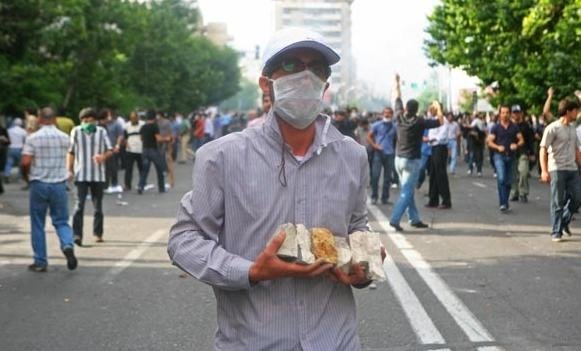 Demonstrators in Tehran fighting back forces of the regime, Saturday June 20. Photo by .faramarz However, what we are seeing now in Iran is a genuine mass revolutionary movement, which was sparked by the election campaign and election fraud, but which reflects a much deeper malaise on the part of the Iranian masses. The vicious oppression of women and youth, the worsening conditions of workers, who are brutally deprived of their most basic trade union rights, the general impoverishment of the population at a time of high oil prices, the hypocrisy of the clerics, etc. All of these factors have given rise to this extraordinary mass movement, not a handful of foreign agents, as the regime alleges.
Demonstrators in Tehran fighting back forces of the regime, Saturday June 20. Photo by .faramarz However, what we are seeing now in Iran is a genuine mass revolutionary movement, which was sparked by the election campaign and election fraud, but which reflects a much deeper malaise on the part of the Iranian masses. The vicious oppression of women and youth, the worsening conditions of workers, who are brutally deprived of their most basic trade union rights, the general impoverishment of the population at a time of high oil prices, the hypocrisy of the clerics, etc. All of these factors have given rise to this extraordinary mass movement, not a handful of foreign agents, as the regime alleges.
Furthermore, while we stand implacably against any imperialist intervention and bullying of Iran, this does not mean in any way that we defend Ahmadinejad or the Islamic regime. During his presidency, the brutality of the regime against workers, women, youth and the people in general, suppressing their most elementary democratic and economic rights, has continued unabated (under a mask of “anti-imperialist” rhetoric). At the same time, we do not have any trust in Mousavi, someone who also comes from the core of the regime itself, who was responsible during his period as prime minister for the killing of 30,000 left wing and trade union activists. He has only discovered “reform” now, because he fears that the whole regime might be swept away. It might be too late for him.
Iran’s Islamic Republic has not an ounce of progressive content. The regime was consolidated in 1979-82 by crushing the workers’ revolution which had overthrown the Shah. The disastrous policies of the Communist party and other left wing organisations paved the way for that defeat (See The Iranian Revolution by Ted Grant, 1979). The workers’ councils (shoras) had to be smashed and tens of thousands of left wing, trade union and youth activists killed for the regime of the mullahs to consolidate its power. In order to so, the mullahs resorted to verbal anti-imperialism as a way of getting mass support, but that should not fool anybody as to the real character of this reactionary dictatorship. We are firmly on the side of the workers, the youth, the women and the poor of Iran, and against all sections of the regime and imperialism.
Which way forward?
Once again, Mousavi, after not having given any clear lead over whether to demonstrate or not (rumours of an important message from him were heard all day Saturday, but people came out regardless), issued a strongly worded message. He even said that in case he was arrested the people should go out on a national strike. However radical his words might sound, he is only following the movement, not leading it. His mention of the general strike is only a reflection of the many discussions taking place in the mass movement. For instance, there is an unconfirmed call by a student organisation for a general strike on Tuesday:
“All workers and government and non-government workers, except workers of hospitals, health centers and fire-fighting agencies, are therefore requested not to attend their jobs on Tuesday, the 2nd of the month of Tir”.
We have argued before that only the entry of the working class in the movement in an organised way can guarantee its victory. So far we know that the Khodro car workers and the Vahed Bus Drivers have come out openly in support of the movement, and there might be others. This is a very significant step forward, but as of yet it has not translated into decisive action. However, this can change very rapidly. Any “accident” (an incident of particularly brutal repression, a provocative statement by Khamenei, …) can quickly trigger a wave of strikes.
It is not clear what will happen this week. If no clear way forward is shown to the masses, it is possible that brutal repression will bring the movement to a temporary halt. Even if that is the case, the lessons of the last week will not be lost. The consciousness of millions of Iranian workers, women, youth and ordinary people has been fundamentally transformed. Not only they have come to see the regime as their main enemy, they have also had a glimpse of their own power and have seen that it is possible to defeat it. The Iranian revolution in 1979 did not take place in one single act, but developed over many months of struggle until the final overthrow of the hated Shah. But a temporary lull in the movement is by no means the only possible outcome. If a strike movement starts to develop this week, then the movement would have a new lease of life.
All Iranian activists should now concentrate on this. Students should by all means attempt to make contact with the worker activists who have been fighting over the last few years in the growing Iranian labour movement. Worker activists in the factories should test the mood. Organise discussions and where possible mass assemblies to discuss the current movement, the role of the working class and the organisation of strikes and work stoppages. The mood in the country in general is one of heightened political discussion. The factories and workplaces are not immune to this. Worker activists should still be very cautious and keep their organisations and networks hidden from the authorities. However, once an important section of the working class comes out, the damn will be broken. Workers’ councils (shoras) should be set up, based on mass assemblies and democratically elected spokespersons.
What we are witnessing in Iran is the beginning of a revolution, with all its contradictions, where the masses bring all their prejudices and confusion from the previous period, but at the same time, these will be rapidly thrown away and replaced by the most advanced ideas and consciousness. A revolution will necessarily have ebbs and flows. The masses cannot be on the streets 24 hours a day, 7 days a week. Particularly because of the weakness of the revolutionary leadership it will develop over a protracted time. What is clear is that the revolutionary movement of the masses has begun. The clashes over the last weekend mark another turning point. It is the duty of revolutionary activists all over the world to offer support and assistance to the mass movement in Iran, while at the same time studying the current movement and the revolutionary history of the country in detail. We all draw enormous inspiration from the courageous movement of a people which has said enough!
Freedom of speech, organisation and media!
Freedom of trade union organisation and the right to strike!
For a general increase of wages!
Prepare a general strike!
Down with the dictator, down with Khamenei!
Down with the regime, for a revolutionary Constituent Assembly!

